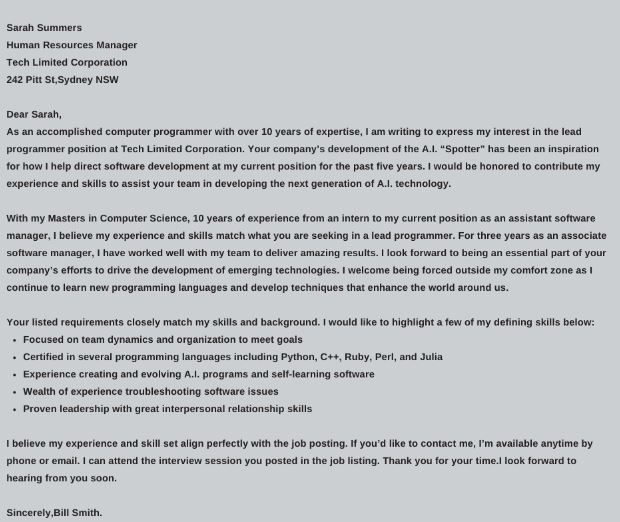Cover letters are an essential element to applying for jobs, especially for those highly sought after positions where hundreds of people apply. Imagine submitting your application package into a whirlwind of applications that the hiring manager has to comb through. How do you stand out in that storm? That’s right, your cover letter.
A cover letter is your personal statement to address why you are the best fit for the position. It helps fill the gaps in your resume, allows you to present yourself before the interview, and persuade your future employer why you are the best fit.
Many people think very little about cover letters. They consider them antiquated in our modern times of auto-fill applications that sort your resume information or scan your LinkedIn profile. Why make a personal statement when your resume can stand on its own?
We’ll explain why cover letters can be your golden ticket to snagging that dream job: how they work, what employers think of them, and most importantly, how to write an amazing cover letter.
Consider this guide to be your ultimate source of writing a cover letter, what your mindset around them should be, and how to set yourself apart from the pack to hiring managers.
What is a cover letter?
A cover letter is a formal message included in your job application. It’s a letter, about 250-350 words in length explaining why you’re a perfect applicant for the job. You can use it as a letter of introduction that can push a hiring manager to call you in for that interview.
A good cover letter convinces a hiring manager that you’re the perfect applicant for the job by pointing out how the experience on your resume can be used for the position. It convinces them that even the smallest details in your resume can be your greatest strengths. It also helps to bridge gaps in your resume with supporting details.
A bad cover letter, however, comes off as a waste of paper and ink. It wastes the time of the hiring manager reading it and brings them to toss it in the recycling bin. Regardless of whether your resume is amazing, a bad cover letter can bin your application in a heartbeat.
The pre-interview statement
Hiring managers have to sift through a stack of applications to find a handful of people to interview for their open position. When they receive a stack of applications, they’re likely to sort first by resume and pick out those who don’t have the required experience.
Within the newly shortened stack of those who are qualified for the position, these hiring managers have to then select only a few applicants to call for an interview. Your cover letter is what can set you apart. It acts as a pre-interview statement of why you think you’re the best candidate for the job.
If the hiring manager is thrilled by how you present yourself with your cover letter, how well you understand their company and the position you’re applying for, and how well you write about yourself, they’ll likely call you for an interview.
Your resume qualifies you for the position; your cover letter sparks interest in you as an applicant.
“But I heard some employers don’t read it” you might be wanting to say.
Some employers don’t bother reading cover letters. They’ll hire a person based on their resume and interview. But there’s often a reason for this:
- Perhaps the job has extremely high qualifications that few applicants can fulfill, thus with the small pool of relevant applicants, it’s worth interviewing them all.
- Perhaps a hiring manager doesn’t see value in cover letters–they’ve read too many that all read the same.
- Or perhaps an employer is using other methods to weed out the applicants, like reading through LinkedIn profiles.
However, it’s safe to assume that most employers and hiring managers do value cover letters, even if they barely glance at them. When you’re applying for a job you’ve dreamed of for years and took on study and work to achieve, it’s best to ensure that every little detail is perfect – regardless if it’s seen or not.
Don’t let the naysayers tell you not to put your best effort into your application. Show how important landing this job is to you by putting all your abilities behind everything you do.
How to write a cover letter
Let’s first start by reading through a well-crafted cover letter as an example. While reading this, put yourself into the shoes of the hiring manager on the other end.
While you read, ask yourself these questions:
- Who is this person?
- Do they grab my attention?
- Do they understand the position?
- What relevant skills do they have?
- Why should I hire them?
- Are they a good fit for my company?
The context for this cover letter is for a job posting for a Lead Programmer for a company that designs A.I. software. The hiring manager is looking for someone who can lead, but also program with the group and displays the experience and skills to back up their claims.

Cover letter breakdown
To best understand how this cover letter is working, let’s break down the essential elements, step by step:
Hiring Manager’s Information
“Sarah Summers
Human Resources Manager
Tech Limited Corporation
242 Pitt St,
Sydney NSW 2000
As with any letter, this is to be addressed to the person who will be reading this. It shows a personal touch which helps establish a connection to the hiring manager. Don’t forget to check the correct spelling of their name as that can be a major put off.
If you are unable to learn the name of who you should be directing the letter to, you may use the title of the person you are writing to, or, if you don’t know that, “Hiring Manager” is fine.
Letter opening
This is where you focus your efforts on introducing yourself. Please be aware that hiring managers might not have looked over your resume yet, so be clear about your qualifications.
“As an accomplished computer programmer with over 10 years of expertise, I am writing to express my interest in the lead programmer position at Tech Limited Corporation.”
This sentence is direct with its message. It declares the person’s wealth of experience and that they are accomplished in their field. This grabs the reader’s attention as experience is valuable in a leadership role.
It’s important here to start to address that this cover letter isn’t a “fill-in-the-blank” affair that many people copy. The writer precisely names the job position and company name and adds that they are interested in the position. This is a simple start, but effective in grabbing the reader’s attention.
“Your company’s development of the A.I. “Spotter” has been an inspiration for how I help direct software development at my current position for the past five years.”
This part can be tricky to nail down. This continues by establishing how the writer knows of this company, how they value it, how they view the company as a whole.
Here the writer does two different jobs. One, they specifically name the software, the “product” of the company, and explain it is an inspiration to their current success. It tells the hiring manager this person is well acquainted with the company and not just throwing out a job application haphazardly. Two, the writer addresses that they have been at their current company position for five years.
While addressing that the company on a personal level isn’t necessary, it holds great value in the hiring manager. The applicant clearly shows they understand what this company does, has made it a focus of their ambitions, and has the motivation to work there.
“I would be honored to contribute my experience and skills to assist your team in developing the next generation of A.I. technology.”
This is when the writer focuses on how they can contribute to the company if they are placed in the position they are applying for. This shows great initiative and drives towards the company’s focus.
Cover letter body
Overall, the cover letter’s body should focus on displaying yourself. It’s important to drive home your achievements and what your experiences and skillsets are. This is where you sell yourself, outside your resume, while providing additional detail that can expand on what your resume says.
An important note: While this section is focused on your experience and skills, it’s important to fold that into the position you are applying for. Also, focus on what you can deliver to the company if you were hired.
“With my masters in computer science, 10 years of experience from an intern to my current position as an assistant software manager, I believe my experience and skills match what you are seeking in a lead programmer.”
Here the writer pulls out their biggest accomplishments. Relevant college degrees show dedication to the career field. Experience and growth through that experience show passion in what the writer works towards. This is also where you can connect your current job with the one you are applying for. With this section, it’s clear that an assistant software manager might be looking to step up as a lead programmer.
If the top skills and experience in your resume don’t match up with the job you are applying for, this is where you can focus your relevant skills towards the job you are applying for. You can pinpoint the small areas of your resume and expand on them in this part of the cover letter.
“For three years as an associate software manager, I have worked well with my team to deliver amazing results. I look forward to being an essential part of your company’s effort to drive the development of emerging technologies.”
Aside from pure skill, this job would require working as a part of the team. A lead programmer isn’t just someone who orders others around, they are an important part of the team. The writer highlights that they understand that. He focused on his current experience and how he can benefit the company by delivering that same experience as a part of their team.
Again, the writer displays that they understand the company’s focus and offer themselves as a benefit towards that goal.
“I welcome being forced outside my comfort zone as I continue to learn new programming languages and develop techniques that enhance the world around us.”
Here we see the writer state that they aren’t static in their development. They look forward to being challenged and adapting to what the job would require.
For a hiring manager, this is a great point. Oftentimes hiring managers must train and develop even the most experienced new employees to meet company standards. Displaying you are flexible and capable of change is a great way to let your skills and experience seem adaptable and transferable.
Highlighting your skills
While not necessary, breaking relevant skills that you pull from your resume into bulleted points can be a great way to make your resume more readable. It also helps focus the hiring manager’s eyes on specifically listed skills.
“Your listed requirements closely match my skills and background. I would like to highlight a few of my defining skills below:
This section simply refers back to the job requirements as the writer states they are fulfilling what was posted in the job requirements.
- Focused on team dynamics and organization to meet goals
- Certified in several programming languages including Python, C++, Ruby, Perl, and Julia
- Experience creating and evolving A.I. programs and self-learning software
- Wealth of experience troubleshooting software issues
- Proven leadership with great interpersonal relationship skills”
This section is listed in descending order of importance. The first point is the most important part of the job, the team, and the company’s goal. Without this, it could seem the writer is lost in the direction of the position.
This is also where certification and other qualified skills can be placed. Here, the writer focuses on their specific certifications that are relevant to the field of A.I. technologies. Python is the main programming language here, so it’s first on the list as well.
The other points start to focus on the smaller aspects of the job, and they bring in specific points of experience that are noteworthy.
Closing paragraph
“I believe my experience and skill set align perfectly with the job posting. If you’d like to contact me, I’m available anytime by phone or email. I can attend the interview session you posted in the job listing. Thank you for your time.”
This is a wrap-up paragraph. It can restate the writer’s experience and relevance to the job posting. Here you can detail how and when the hiring manager can contact you and any additional information that might have been requested from the job posting.
With the example job posting, it might have listed a possible interview date, so the writer clearly states they are available for it. Most often, hiring managers will contact applicants to ask if they are available for an interview, so stating that you are is a quick way to cut that hassle out of the process.
“I look forward to hearing from you soon.”
This is a simple salutation. It’s best to word this positively, showing confidence that you might be asked for an interview.
You can be more assertive with an ending message like, “I will follow up in two weeks to ask you if you require additional information.” State this at your own risk as this can come across as too assertive. Regardless, a follow-up call can be valuable, even if you don’t state that you will do it.
Finally, the End
“Sincerely,
Bill Smith.”
There is no need to deviate from this ending message. It’s simple and sweet.
Wrapping up the cover letter
With this detailed breakdown, we hope you’ve come to understand the elements that make up an amazing cover letter. There are many small areas where you can drive home how you’re the perfect applicant, and areas where you can expand on your resume.
Top 10 Tips
Now that we’ve gone over what makes a great cover letter, let’s highlight some specific points that you should focus on.
1. Write fresh cover letters
Imagine you’re a hiring manager who has to read through dozens, hundreds, if not thousands of cover letters. You’ll quickly become aware that many applicants copy and paste cover letter templates, or use one they’ve written and filled in the blanks with relevant company info.
What can make you truly stand out when applying for a position is writing a fresh cover letter, completely personalized, and addressing the company and position directly. This shows the hiring manager that you value the application phase as much as you would value working for the company.
If you’ll be applying to many similar companies, craft an amazing cover letter and then rewrite that cover letter for each application. The first cover letter is a learning experience. When you write the proceeding ones without looking at the first, you’ll be able to focus more on that specific application while borrowing your developed skills.
2. Ask someone to review it
Writing is one of those skills that can be interpreted differently when someone else reads it. It’s important to understand what the reader’s reaction is, and you can achieve this by asking friends, family, or even your neighbour to read your cover letter.
Ask them for their personal opinion of it. Would they hire you? Are they confused about areas? Do they think you don’t need certain lines, or are they weak? Are there areas of interest you should focus on more?
This is a critique to help you refine your cover letter. You can identify problem areas you weren’t aware of, help focus on points, and see how the hiring manager might respond. This is also better than having your application tossed in the recycle bin to never know how the hiring manager responds.

3. Display knowledge of the job
This might be a no-brainer tip, but many people fumble displaying knowledge of the job they’re applying for. They believe that stating their experience and skills and saying, “I’m a perfect fit for this position” is enough.
However, more often than not, just stating your experience isn’t enough. You need to address the job posting. Understand exactly what the job is and when writing your cover letter, focus on how you can do the job in the way it’s being asked.
Read over the job posting and see how it’s written. The most valuable skills the employer wants would be focused near the top of their listing, the least valuable near the bottom. So focus more accordingly, from the top to the bottom.
4. Display knowledge of the company
This is a point many job applicants don’t focus on but is vital. In fact, one common question in a job interview is, “What do you know about our company?” Many people flop like a fish when asked this question; they simply applied for the job without understanding the company itself.
So before you write your cover letter, research the company. Read the company website, read recent news articles about it, read the Wikipedia page on it.
Then use this knowledge to your advantage by applying the company info to your cover letter. Show that you have an interest in this company, not just the position it offers.
5. Sell yourself
Most people have issues with selling themselves. Normally, we try to stay humble and downplay our achievements. But a cover letter isn’t where you should do that!
The purpose of the cover letter is to convince the hiring manager to offer you an interview. Just like the description of a product online you wish to buy, this writing is an advertisement to make the hiring manager offer an interview.
However, the opposite is true in some cases. You can sell yourself too much and come off narcissistic and crass. This is where you should focus your efforts on selling yourself on how you benefit the company. If you were in the position, how well could you help the company reach its goals? Because of this, you’re not selfish, but beneficial.
6. Expand on your resume
As mentioned, a cover letter can help expand on smaller points on your resume, and help bridge gaps between your resume and the job requirements.
Try to analyse your resume. It should be clear and concise and list all your achievements. But because of that, it comes off unexciting, and some achievements should be valued far more than others. Locate all the strong and weak points.
When you write your cover letter, redefine how the hiring manager should look at your resume. This is your chance to both back up your resume and help it become far more valuable to you.
7. Formatting, fonts, spacing, and margins
Hiring managers have to read through hundreds of applications and cover letters. Even if your cover letter has been written perfectly, if the formatting is off it’ll be hard to read. If a hiring manager is tired after a long day, they might skip a horrendously formatted application.
The example cover letter displayed the basic formatting:
- Your information should be at the top right
- The recipient’s information should be on the left and the body of the letter below
- The length of the letter should be between 250-350 words
- Fonts should always be easily readable, either Arial, Verdana, or any “serif” fonts, like Times New Roman
- Cover letters should be single-spaced with a space between sections and paragraphs
- No indentation needed
8. Be professional
This should go without saying, but some hiring managers have experienced cover letters that don’t display professionalism. These applicants have used slang, words that aren’t very technical, and sometimes some wording can be rude.
Understand you’re applying for a job at a company, and the majority of companies are very professional. Treat the cover letter as a display of how professional you are, just like wearing proper interview attire.
9. Don’t waste words
A cover letter is between 250-350 words. That’s a very short letter to display your amazing talents to the hiring manager. Use your words wisely; every sentence should drive a spectacular point home, or do multiple duties at once.
This is where many template cover letters falter. They use very general wording to help people fill in the blanks, but when a hiring manager reads them, their eyes start to skim. There’s no valuable content, just many words that aren’t being precise.
If you’re struggling with finding the right words, sit down for a while, and write and rewrite the same sentence many times. You’ll start to hone in on powerful language.
10. Show you’re willing to attend an interview
The job of a cover letter is to help convince the hiring manager to give you a call for an interview. Near the end, always include some part about being willing to attend an interview, even if that’s stating when you’re available for an interview.
Good luck!
If you’re keen to chat about your career, drop us a line on 1300 738 955 or check out our courses here.





